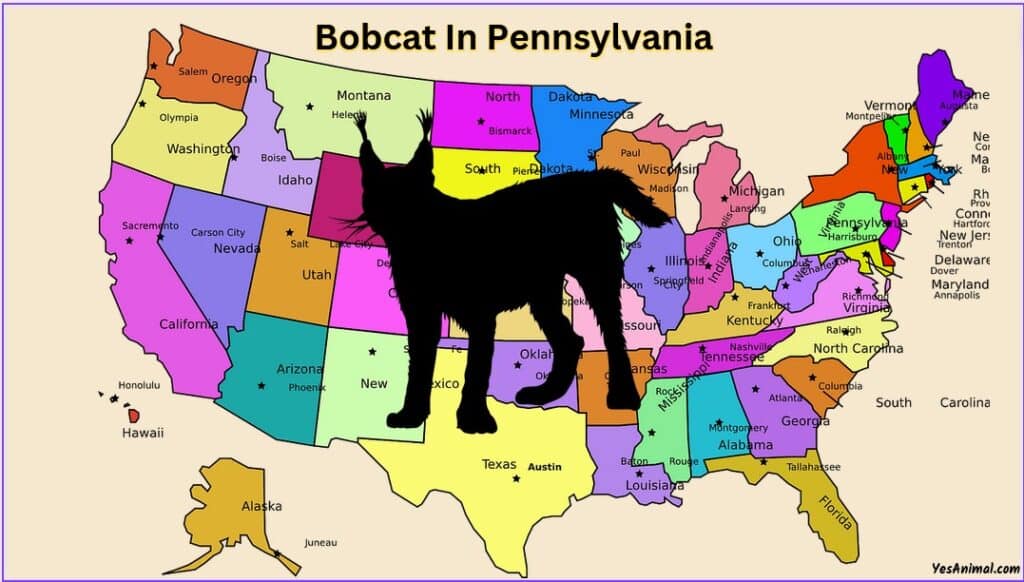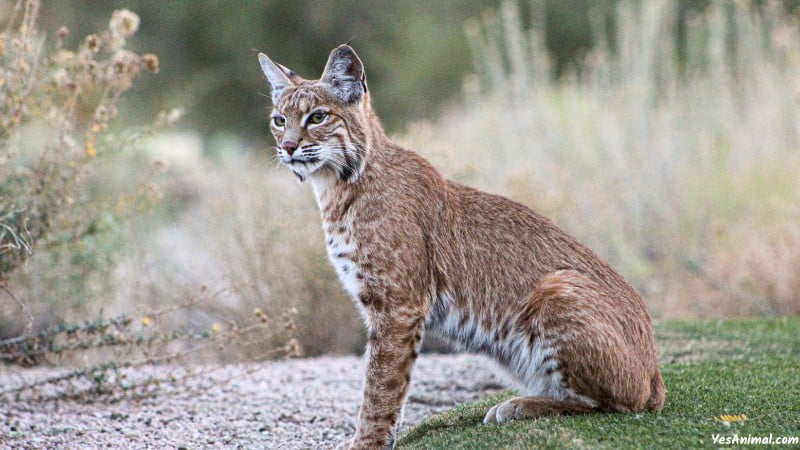Last Updated on April 15, 2024 by Amin Tawar

From the short howls of coyotes to the high-pitched whistling of bald eagles, forests and other landscapes of Pennsylvania are filled with the natural sound of distinct lifeforms.
The state’s ability to offer a wide range of habitats makes it one of the few states with a diverse population of flora and fauna. While the state is not home to big cats like lions, tigers, panthers, etc, the state does host bobcats.
While they aren’t more common as other animals, as a top predator, Bobcats play a significant role in nature.
Below I’ve explained all the things you need to know about the presence of bobcats in Pennsylvania.
Are There Bobcats in Pennsylvania?
Yes, there are bobcats in Pennsylvania. Historically, bobcats are native to Pennsylvania. However, in the mid-1800s, these wild cats were considered vermin, and various bounties were placed which led to a drastic rise in bobcat killings.
As there was not much change in the surroundings, bounties were dropped in 1938. However, as they remained unprotected there was unregulated hunting of bobcats and soon only a few remained in the state unit in 1970.
In 1970, as bobcats were designated as furbearers, the state agency was able to set regulations to manage the bobcat population. This led to a gradual increase in the bobcat population which now has become stable. While bobcats maintain a healthy population in the state, due to their elusive nature, it’s often difficult to spot them.
Where do bobcats live in Pennsylvania?
Bobcats are known to inhabit various states of the United States of America, including Pennsylvania. These wildcats are mostly observed in the forested regions in the north and center parts of the state.
North Pennsylvania’s Pocono Mountains and Allegheny National Forest to name a few provide dense forest covers which are a suitable habitat for bobcats.
In the central region, there are mountainous regions and state forests that also host bald eagles. This mix of landscapes offers a diverse range for these wildcats.
While bobcats are very adaptive and can survive in a variety of landscapes, they however avoid cities and towns where there is a dense human population.
How Large Is a Pennsylvania Bobcat?

Pennsylvanian bobcats have sizes similar to bobcats found in other states. These efficient predators are mid-sized felines. However, it’s important to note that bobcats are about twice the size of domestic cats.
An adult bobcat measures 36 inches in length with a 6-inch stubby tail and stands at a height of 1 to 2 feet tall.
In terms of weight, an adult male bobcat weighs on average anywhere between 18 to 24 pounds and a few large bobcats also reach 35 pounds. As bobcats are sexually dimorphic, adult males are typically larger than adult female bobcats.
While bobcats across the country are of similar size, there may be a few variations in their sizes due to the type of habitat, availability of prey, presence of humans around the habitat, presence of competition, time of the year, etc.
Also Check Our Guide On Bobcats In US
Are Bobcats Aggressive in Pennsylvania?
No, Bobcats are not aggressive in general. In fact, these cats are very shy and avoid any confrontation with humans. Most of the time, they either hide or run away when in proximity to any human.
However, similar to other wild creatures, bobcats may turn aggressive and defensive if cornered or if it perceives you as a threat. This may be the case when food is involved. Remember, bobcats are double the size of domestic cats and can overthrow an adult deer.
Therefore, while it is rare for a bobcat to attack humans, always be cautious and attentive when traveling in the wild, especially in areas where bobcats are well documented. Respect their space and never pop up in front of them suddenly.
What do bobcats eat in Pennsylvania?
Bobcats’ diet depends on the type of prey and food sources available in their habitat. While bobcats are known to travel for mates, they might sometimes even migrate from a place if there’s a scarcity of food.
In general, bobcats’ diet consists mostly of small mammals like rodents, rabbits, squirrels, birds, and hares. Though rare, these opportunistic hunters are also known to consume muskrats, fish, frogs, and even injured and crippled deer. Bobcats also scavenge on weak whitetails that have starved or died.
One unique fact about bobcats’ diet is that these wildcats are strictly carnivorous. Therefore, unlike other forest predators, these fierce creatures do not consume mast or fruits. Overall, bobcats are very resilient and will adjust their hunting strategies based on local conditions and seasonal changes.
Can You Kill a Bobcat in Pennsylvania?
Yes, you can kill a bobcat in Pennsylvania with a valid license/permit. The Pennsylvania Game Commission is responsible to manage bobcat hunting and trapping in the state.
As per the commission, bobcat hunting is regulated using a permit system. In addition to permits, specific hunting season, and bag limits are introduced by the agency to support the sustainable management of the bobcat population in the state.
As responsible residents of the state, it is important that we follow these regulations and help maintain and preserve the bobcat population in the state.
Additionally, as regulations and permit requirements change over time, it is very important to check the latest hunting and trapping rules before arranging any activities related to bobcats in the state.
Can You Own a Bobcat in Pennsylvania?
Yes, you can own a bobcat in Pennsylvania. However, before making such a decision be sure that you can support and take care of them. As bobcats are wild animals, they require specialized care and constant monitoring which is difficult in a domestic setup. Moreover, due to their wild nature, they may develop various diseases which may be sometimes even fatal to humans.
Bobcats are classified as exotic animals in Pennsylvania and are regulated by the Pennsylvania Game Commission and the Pennsylvania Department of Agriculture. To own these wildcats, individuals need to apply for and obtain the necessary permits.
Remember, these permits are generally issued for educational, rehabilitation, and research purposes. So, any other reason may lead to rejection. However, as these rules may change over time, it is always important to be updated regarding the requirements.
What To Do If You See a Bobcat in Pennsylvania?
Bobcats are solitary and elusive which makes it difficult to spot them in the wild. However, these adaptable creatures have now started moving into suburbs on the outskirts of the city. While bobcats rarely exhibit aggressiveness, it is always important to be cautious and avoid any encounter with them.
To avoid their movements near your place, make sure that all the food sources like pet food and garbage are indoors or contained outdoors. As these wild creatures sometimes even consume domestic animals and pets, make sure that your pets are safe and indoors.
However, if you do see one, maintain distance and convey your presence by making loud noises. Observe them quietly and report them to the Pennsylvania Game Commission.
Also Check Our Guide On Bobcats In North Carolina
Conclusion
And that was everything you need to know about the Bobcats In Pennsylvania. I hope this article was infromative and your queries were answered.
Thank You For Reading!
Our Goto Source For This Guide